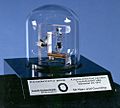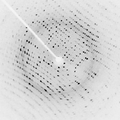Condensed matter physics facts for kids
Condensed matter physics is a super interesting part of physics. It studies how matter behaves when its tiny parts, like atoms and molecules, are packed very close together. Think about everyday things like solids and liquids – that's what condensed matter physicists study! They look at how these materials get their special properties, like why a metal can conduct electricity or why a magnet sticks to your fridge.
This field helps us understand how materials work at a very deep level. It's all about figuring out the secrets of everyday stuff around us, from the screen of your phone to the magnets on your fridge.
Exploring the World of Materials
Condensed matter physics is the biggest area of physics today. It focuses on how large groups of atoms and molecules act together. When these tiny particles are very close, they can interact in complex ways. These interactions give materials their unique properties.
For example, some materials are hard, like a diamond, while others are soft, like rubber. Some conduct electricity easily, like copper, and others don't, like plastic. Condensed matter physicists try to understand why these differences exist. They also look for new materials with even more amazing properties.
Why is This Physics Important?
This field of physics is incredibly important because it helps us create new technologies. Many of the devices we use every day are possible thanks to discoveries in condensed matter physics.
Think about your smartphone, computer, or even the lights in your house. All of these rely on materials with specific electrical or optical properties. Understanding these properties helps engineers design better and faster electronics. It also helps us develop new materials for everything from stronger buildings to more efficient solar panels.
Amazing Discoveries and Inventions
Condensed matter physics has led to many groundbreaking discoveries over the years. These discoveries have changed our world in big ways.
The Transistor: A Tiny Switch
One of the most important inventions from this field is the transistor. Invented in 1947 at Bell Labs, the transistor is a tiny electronic switch. Before transistors, computers used large, hot, and fragile vacuum tubes. Transistors are much smaller, use less power, and are more reliable.
The invention of the transistor made it possible to build tiny, powerful computers. This led to the development of personal computers, smartphones, and all the digital technology we use today.
Superconductors: No Resistance!
Another exciting discovery is superconductivity. This happens when certain materials can conduct electricity with absolutely no resistance. Imagine electricity flowing forever without losing any energy!
The first superconductor was discovered in 1911 by Heike Kamerlingh Onnes. He found that mercury lost all its electrical resistance when cooled to a very low temperature. Scientists are still working to find materials that superconduct at higher temperatures, which could lead to super-efficient power grids and even levitating trains!
Quantum Hall Effect: Precise Measurements
The quantum Hall effect is another fascinating phenomenon studied in condensed matter physics. It describes how electrons behave in very strong magnetic fields and at very low temperatures. This effect allows for extremely precise measurements of electrical resistance. It's so precise that it's used as a standard for electrical resistance worldwide.
Bose-Einstein Condensates: A New State of Matter
Scientists have also discovered new states of matter. One example is the Bose–Einstein condensate (BEC). This state occurs when a gas of atoms is cooled to temperatures incredibly close to absolute zero. At these extreme temperatures, the atoms behave like one giant "super-atom." BECs help scientists study quantum mechanics in a new way.
Looking to the Future: Nanotechnology
Condensed matter physics is also at the heart of nanotechnology. This field involves working with materials at the "nano-scale," which is incredibly tiny – about a billionth of a meter!
At this scale, materials can have very different properties than they do in larger forms. Scientists are exploring how to build tiny machines and devices using individual atoms and molecules. This could lead to amazing new technologies, like super-small computers, new medical treatments, and incredibly strong and light materials. Imagine tiny robots that can fix things inside your body!
Images for kids
-
Heike Kamerlingh Onnes and Johannes van der Waals with the helium liquefactor at Leiden in 1908
-
A replica of the first point-contact transistor in Bell labs
-
A magnet levitating above a high-temperature superconductor. Today some physicists are working to understand high-temperature superconductivity using the AdS/CFT correspondence.
-
Image of X-ray diffraction pattern from a protein crystal.
-
The first Bose–Einstein condensate observed in a gas of ultracold rubidium atoms. The blue and white areas represent higher density.
-
Computer simulation of nanogears made of fullerene molecules. It is hoped that advances in nanoscience will lead to machines working on the molecular scale.
See also
 In Spanish: Física de la materia condensada para niños
In Spanish: Física de la materia condensada para niños








